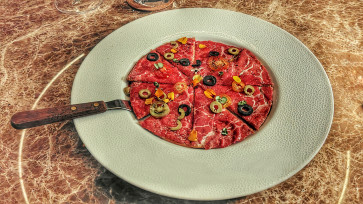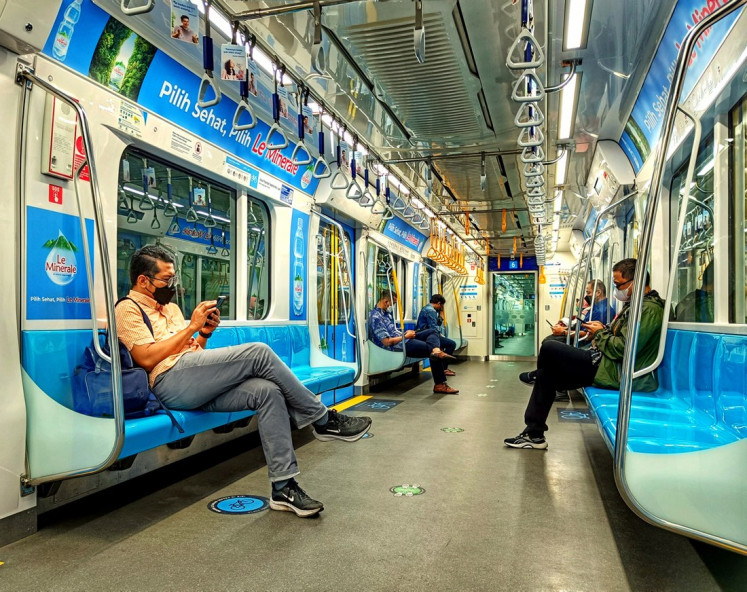Popular Reads
Top Results
Can't find what you're looking for?
View all search resultsPopular Reads
Top Results
Can't find what you're looking for?
View all search resultsNatural flavor in Bali’s fine dining
Be it near the beach, the rocks or in a beautiful garden, Bali has almost all the locations to enjoy a magnificent feast
Change text size
Gift Premium Articles
to Anyone
B
e it near the beach, the rocks or in a beautiful garden, Bali has almost all the locations to enjoy a magnificent feast.
The island’s natural beauty not only charms visitors, but is also an endless source of inspiration for decor ideas. Two fine dining restaurants in the island try to capture the best part of this nature and marry it with their architecture, while offering their own delicacies.
Established in 2000, Ku De Ta in Seminyak in Badung regency has an open-air design that provides the finest way to enjoy its superb backdrop — the white sandy beach and surfing waves of Seminyak. Meanwhile, the Mozaic restaurant and lounge, emulates the green image of Ubud. Opened in 2001, the award-winning, fine-dining restaurant highlights tropical gardens as its theme.
Ku De Ta general manager Steve Collinson said the restaurant had seen a number of developments from the original building, which was designed by French architect Fredo Taffin of Espace Concept.
Having three bars, the U-shaped restaurant boasts a variety of areas for different purposes. The main building of the restaurant is the main dining room where visitors can dine or enjoy drinks at the bar.
Fidel’s cigar bar, which is located in a wing of the restaurant, has a completely different atmosphere with two chandeliers and the warm wood tones of its casual leather couches. Next to the bar is a communal dining area called Sexion 9, which has long tables set out and blue sofas intended to give a chance to mingle.
Across from Fidel’s is the Beach bar, which has a simpler design. An open, bright breakfast area is located next to the bar, offering an intimate view of the beach.
Collinson said the restaurant developed Fidel’s in 2004 to cater to the growing number of tourists.
“We made the bar five meters longer and we designed the communal dining area and the day-bed area at the same time. It was done to cope with the amount of business that was coming in the door and to keep things fresh,” he said.
The restaurant gave another retouch to the interior and exterior in 2007. Collinson said they made the pool longer, redeveloped the main bar, the beach bar and developed the upstairs dining area. Ku De Ta changed the concept of the upper story last year and they are in the middle of introducing a new concept this year.
The design of Ku De Ta may develop, but it retains the same simple stylish style and woody tone. Collinson said all the interiors are made in Bali and they never stick to one particular architect during the development process.
“It’s a very open space, minimalist and still very sleek after all these years. Simplicity works for us,” he said.
While the beach is the main attraction that inspires the open plan of Ku De Ta, Mozaic in Ubud offers a tropical garden feel in its restaurant Gastronomique.
Tropical trees and plants with warm lighting are the main attraction, setting up a romantic mood for dining. Meanwhile, the lounge has an elegant style with big white comfortable couches, small square tables and red-toned walls. Chef and owner Chris Salans said the restaurant’s location, Ubud, was the main inspiration for the tropical garden ambience.
“The location is so enchanting. There was never any doubt in my mind that it should be a garden-set restaurant. Tourists and locals alike enjoy eating in the garden or with a view of the garden, so we could not do without that aspect, in my opinion,” he said in an email to The Jakarta Post.
The author of the cookbook Mozaic: French Cuisine, Balinese Flavours, he said that Bali’s rich and fresh ingredients are his primary inspiration, which makes the garden an intrinsic part of the concept.
During the development, he planned a pathway around the main trees and plants to save many indigenous plants such as belimbing wuluh (tree sorrel). When he set up the cooking school, he selected the ingredients needed for the classes and planted herbs, such as lemongrass and chili ,in the garden.
“We have a one-meter tamarind tree which has been producing 10-centimeter-long asam since the first months it was transplanted. It’s a dream come true for me,” Salans said.
The restaurant, he said, saw a few changes to the entrance and the arrival space with the opening of the Lounge in 2007. The pavilion got more color and the red tone on the walls in 2006.










